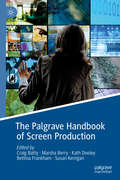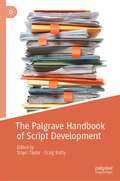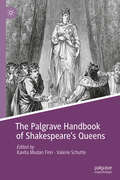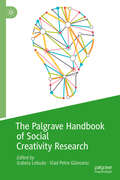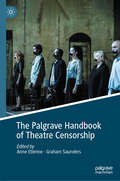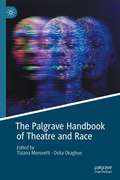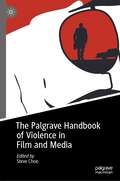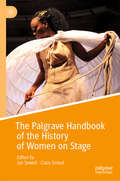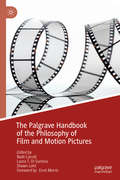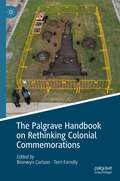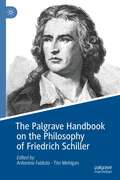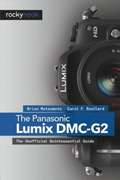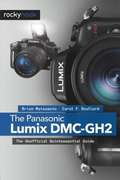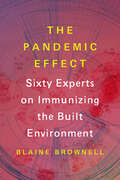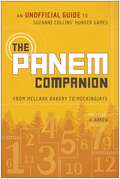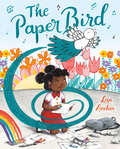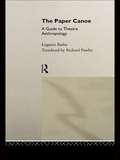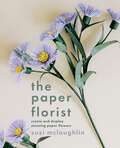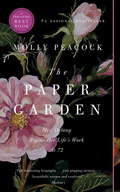- Table View
- List View
The Palgrave Handbook of Screen Production
by Craig Batty Marsha Berry Susan Kerrigan Kath Dooley Bettina FrankhamThis handbook is an essential creative, critical and practical guide for students and educators of screen production internationally. It covers all aspects of screen production—from conceptualizing ideas and developing them, to realizing and then distributing them—across all forms and formats, including fiction and non-fiction for cinema, television, gallery spaces and the web. With chapters by practitioners, scholars and educators from around the world, the book provides a comprehensive collection of approaches for those studying and teaching the development and production of screen content. With college and university students in mind, the volume purposely combines theory and practice to offer a critically informed and intellectually rich guide to screen production, shaped by the needs of those working in education environments where ‘doing’ and ‘thinking’ must co-exist. The Palgrave Handbook of Screen Production fills an important gap in creative-critical knowledge of screen production, while also providing practical tools and approaches for future practitioners.
The Palgrave Handbook of Screenwriting Studies
by Rosamund Davies Claus Tieber Paolo RussoThis book provides an overview of the growing field of screenwriting research and is essential reading for both those new to the field and established screenwriting scholars. It covers topics and concepts central to the study of screenwriting and the screenplay in relation to film, television, web series, animation, games and other interactive media, and includes a range of approaches, from theoretical perspectives to in-depth case studies. 44 scholars from around the globe demonstrate the range and depths of this new and expanding area of study. As the chapters of this Handbook demonstrate, shifting the focus from the finished film to the process of screenwriting and the text of the screenplay facilitates valuable new insights. This Handbook is the first of its kind, an indispensable compendium for both academics and practitioners.
The Palgrave Handbook of Script Development
by Craig Batty Stayci TaylorThe Palgrave Handbook of Script Development provides the first comprehensive overview of international script development practices. Across 40 unique chapters, readers are guided through the key challenges, roles and cultures of script development, from the perspectives of creators of original works, those in consultative roles and those giving broader contextual case studies. The authors take us inside the writers’ room, alongside the script editor, between development conversations, and outside the mainstream and into the experimental. With authors spanning upwards of 15 countries, and occupying an array of roles – including writer, script editor, producer, script consultant, executive, teacher and scholar, this is a truly international perspective on how script development functions (or otherwise) across media and platforms. Comprising four parts, the handbook guides readers behind the scenes of script development, exploring unique contexts, alternative approaches, specific production cultures and global contexts, drawing on interviews, archives, policy, case study research and the insider track. With its broad approach to a specialised practice, the Palgrave Handbook of Script Development is for anyone who practices, teaches or studies screenwriting and screen production.
The Palgrave Handbook of Shakespeare's Queens (Queenship and Power)
by Valerie Schutte Kavita Mudan FinnOf Shakespeare’s thirty-seven plays, fifteen include queens. This collection gives these characters their due as powerful early modern women and agents of change, bringing together new perspectives from scholars of literature, history, theater, and the fine arts. Essays span Shakespeare’s career and cover a range of famous and lesser-known queens, from the furious Margaret of Anjou in the Henry VI plays to the quietly powerful Hermione in The Winter’s Tale; from vengeful Tamora in Titus Andronicus to Lady Macbeth. Early chapters situate readers in the critical concerns underpinning any discussion of Shakespeare and queenship: the ambiguous figure of Elizabeth I, and the knotty issue of gender presentation. The focus then moves to analysis of issues such as motherhood, intertextuality, and contemporary political contexts; close readings of individual plays; and investigations of rhetoric and theatricality. Featuring twenty-five chapters with a rich variety of themes and methodologies, this handbook is an invaluable reference for students and scholars, and a unique addition to the fields of Shakespeare and queenship studies.
The Palgrave Handbook of Social Creativity Research (Palgrave Studies in Creativity and Culture)
by Vlad Petre Glăveanu Izabela LebudaThis Handbook brings together an international cast of experts to explore the social nature and context of creativity studies, focusing on methodology as a key component in advancing the social study of creativity. Two decades on from the pioneering work of Alfonso Montuori and Ronald E. Purser, the authors present a timely appraisal of past and present work in social creativity studies, and look ahead to future developments within this field. The authors collectively offer a rigorous examination of the methodological and empirical issues and techniques involved in studying social creativity. They examine the phenomenon as a form of communication and interaction within collaborative relationships; contending that creativity happens not within a vacuum but instead from a nexus of personal, social and contextual influences.This comprehensive work is organized in three parts, focusing first on the various methodological approaches applicable to the social in creativity studies. It secondly turns to empirical findings and approaches relating to the social nature of creativity. In the book’s final part, the authors offer reflections on the state of social research into creativity, pinpointing areas requiring further methodological scrutiny and empirical verification, and areas that may inspire further theoretical or applied work. Combining classic ideas with cutting-edge, emerging methods, this work provides a vital methodological ‘toolbox’ for investigators within social creativity.
The Palgrave Handbook of Theatre Censorship
by Graham Saunders Anne EtienneThis book incorporates a wide theoretical, cultural, literary and historical engagement in exploring the tension between dramatic productions and the forms of censorship they encounter from creation to reception. The Palgrave Handbook of Theatre Censorship offers global new insights into censorship practices, examining attempts at repression motivated either by fears that audiences gathering together to watch live dramatic events will lead to sedition and mass uprisings, or by moral or religious squeamishness requiring the establishment of institutional systems of censorship to curb or suppress the stage. As such, the Handbook aims to initiate redefinitions of what we understand or experience as censorship. Who knew theatre could (still) carry so many threats, or be so widely provocative and dangerous? This is an extraordinary and often eye-opening set of thirty-six individually insightful, wide-ranging and oftentimes disturbing essays, each of which offers unique insights into theatre censorship practices and their impact within a specific political and moral culture. There is a particular emphasis on the recent and current, and the authors speak with first-hand knowledge and from direct experience not only about the restrictions but also how artists sometimes negotiate and evade these. What makes the book so especially fascinating and illuminating is seeing so many examples juxtaposed together. This enables the reader to hear the essays and the cultures talking to and alongside each other. The collection repeatedly breaks fresh ground, and the editors deserve enormous credit for gathering and effectively curating so many reports from the front-line. Steve Nicholson, Emeritus Professor, University of Sheffield, UK Anne Etienne and Graham Saunders’s book is a wide-ranging, incisive and compelling collection of reflections and case studies on the theatre industry’s relationship to censorship and self-censorship from a historical and contemporaneous perspective. An impressive array of authors have been assembled for this volume representing, among them, views on the subject from Spain, Denmark, Norway, Zimbabwe, South Africa, Germany, Italy, Indonesia, Iran, Portugal, Turkey, Brazil, Japan, Ireland, Australia, Russia, England and more. The book is by turns surprising in its curatorial and narrative design and wonderfully effective at delineating the complex and thorny paths that create socio-political cultures where the censorship and self-censorship of theatre artists thrives and/or is efficaciously contested and rebelled against. Of note is a through line of argument in the book around less overt modes of surveillance that police artists’ imaginations and thereby the work they create and produce. At a time in the world where many governments are increasingly seeking to limit artistic expression, this book is a necessary reminder of the many freedoms that have been fought for in theatres around the globe, and how the power of being unsilenced must never be taken for granted. – Caridad Svich. Playwright & Translator This is a truly excellent collection of incisive studies. It is wide-ranging, impressively global in scope, with an illuminating balance of the historical and the contemporary. In its impressive and well-realised ambition, demonstrated by the well-focused intelligence and academic flair of its many contributors, this collection is both magisterial and vital. It is an essential contribution to censorship studies, fascinating and inspiring, a must-read for anyone interested in the subject. – Aleks Sierz. Theatre critic and author of Rewriting the Nation: British Theatre Today (2011) & Good Nights Out: A History of British Theatre Since the Second World War (2021)
The Palgrave Handbook of Theatre and Migration
by Yana Meerzon S. E. WilmerThe Palgrave Handbook of Theatre and Migration provides a wide survey of theatre and performance practices related to the experience of global movements, both in historical and contemporary contexts. Given the largest number of people ever (over one hundred million) suffering from forced displacement today, much of the book centres around the topic of refuge and exile and the role of theatre in addressing these issues. The book is structured in six sections, the first of which is dedicated to the major theoretical concepts related to the field of theatre and migration including exile, refuge, displacement, asylum seeking, colonialism, human rights, globalization, and nomadism. The subsequent sections are devoted to several dozen case studies across various geographies and time periods that highlight, describe and analyse different theatre practices related to migration. The volume serves as a prestigious reference work to help theatre practitioners, students, scholars, and educators navigate the complex field of theatre and migration.
The Palgrave Handbook of Theatre and Race
by Tiziana Morosetti Osita OkagbueThe first comprehensive publication on the subject, this book investigates interactions between racial thinking and the stage in the modern and contemporary world, with 25 essays on case studies that will shed light on areas previously neglected by criticism while providing fresh perspectives on already-investigated contexts. Examining performances from Europe, the Americas, the Middle East, Africa, China, Australia, New Zealand, and the South Pacifi c islands, this collection ultimately frames the history of racial narratives on stage in a global context, resetting understandings of race in public discourse.
The Palgrave Handbook of Violence in Film and Media
by Steve ChoeThe chapters contained in this handbook address key issues concerning the aesthetics, ethics, and politics of violence in film and media. In addition to providing analyses of representations of violence, they also critically discuss the phenomenology of the spectator, images of atrocity in international cinema, affect and documentary, violent video games, digital infrastructures, cruelty in art cinema, and media and state violence, among many other relevant topics. The Palgrave Handbook of Violence in Film and Media updates existing studies dealing with media and violence while vastly expanding the scope of the field. Representations of violence in film and media are ubiquitous but remain relatively understudied. Too often they are relegated to questions of morality, taste, or aesthetics while judgments about violence can themselves be subjected to moral judgment. Some may question whether objectionable images are worthy of serious scholarly attention at all. While investigating key examples, the chapters in this handbook consider both popular and academic discourses to understand how representations of violence are interpreted and discussed. They propose new approaches and raise novel questions for how we might critically think about this urgent issue within contemporary culture.
The Palgrave Handbook of the History of Women on Stage
by Jan Sewell Clare SmoutThis book brings together nearly 40 academics and theatre practitioners to chronicle and celebrate the courage, determination and achievements of women on stage across the ages and around the globe. The collection stretches from ancient Greece to present-day Australasia via the United States, Soviet Russia, Europe, India, South Africa and Japan, offering a series of analytical snapshots of women performers, their work and the conditions in which they produced it. Individual chapters provide in-depth consideration of specific moments in time and geography while the volume as a whole and its juxtapositions stimulate consideration of the bigger picture, underlining the challenges women have faced across cultures in establishing themselves as performers and the range of ways in which they gained access to the stage. Organised chronologically, the volume looks not just to the past but the future: it challenges the very notions of ‘history’, ‘stage’ and even the definition of ‘women’ itself.
The Palgrave Handbook of the Philosophy of Film and Motion Pictures
by Noël Carroll Laura T. Di Summa Shawn LohtThis handbook brings together essays in the philosophy of film and motion pictures from authorities across the spectrum. It boasts contributions from philosophers and film theorists alike, with many essays employing pluralist approaches to this interdisciplinary subject. Core areas treated include film ontology, film structure, psychology, authorship, narrative, and viewer emotion. Emerging areas of interest, including virtual reality, video games, and nonfictional and autobiographical film also have dedicated chapters. Other areas of focus include the film medium’s intersection with contemporary social issues, film’s kinship to other art forms, and the influence of historically seminal schools of thought in the philosophy of film. Of emphasis in many of the essays is the relationship and overlap of analytic and continental perspectives in this subject.
The Palgrave Handbook on Rethinking Colonial Commemorations
by Bronwyn Carlson Terri FarrellyThe Palgrave Handbook on Rethinking Colonial Commemorations explores global efforts, particularly from Indigenous and Bla(c)k communities, to dismantle colonial commemorations, monuments, and memorials. Across the world, many Indigenous and Bla(c)k communities have taken action to remove, rectify and/or re-imagine colonial commemorations. These efforts have had the support of some non-Indigenous and white community members, but very often they have faced fierce opposition. In spite of this, many have succeeded, and this work aims to acknowledge and honour these efforts. As a current and much-debated issue, this book will present fresh findings and analyses of recent and historical events, including #RhodesMustFall, Anzac Day protests, and the transferral of confederate monuments to museums. Comprising of chapters written by Indigenous, Bla(c)k and non-Indigenous authors, from a wide variety of locations, backgrounds and purposes, this topical volume is a timely and important contribution to the fields of memory studies, Indigenous Studies, and cultural heritage.
The Palgrave Handbook on the Philosophy of Friedrich Schiller
by Antonino Falduto Tim MehiganFriedrich Schiller is justly celebrated for his dramas and poetry. Yet, above all, he was a polymath, whose writings enriched a range of fields including history and philosophy. Until now, no comprehensive accounting of this philosophy has been undertaken. The Palgrave Handbook on the Philosophy of Friedrich Schiller makes good this desideratum, treating Schiller's poetry, prose, and dramatic work alongside his philosophical writings and reviewing his thought not only in connection with those who influenced him, such as Kant, Reinhold, and Fichte, but also those he anticipated, such as Hegel, Marx, and the Neo-Kantians. Topics treated in this volume include Schiller's philosophical background, his theoretical writings, Schiller's philosophical writing in light of his entire oeuvre, and Schiller's philosophical legacy. The Handbook also includes an overview of the main topics Schiller addressed in his philosophical writings including philosophical anthropology, aesthetics, moral philosophy, politics and political theory, the philosophy of history, and the philosophy of education. Bringing together the latest research on Schiller and his thought by leading scholars in the field, the Handbook draws attention to Schiller's undiminished importance for philosophical debates today.
The Panasonic Lumix DMC-G2
by Brian Matsumoto Carol F. RoullardThe Panasonic Lumix DMC-G2: The Unofficial Quintessential Guide provides a wealth of information and professional insights for owners of this powerful HD camera. With its electronic viewfinder and interchangeable lenses, the G2 is capable of not only recording professional-quality still images, but has the added ability to record HD video as well. The mirrorless design enhances the camera's versatility beyond that of most digital single lens reflex (DSLR) cameras. With the appropriate adapters, it can use virtually any manufacturer's manual focus, legacy lens. It is smaller than a typical DSLR in both size and weight, and retains automatic focusing while recording videos - a capability missing in many DSLR cameras. Authors Brian Matsumoto and Carol Roullard explore and explain the features and capabilities of the G2 camera in detail, as they cover everything from the basic features of the camera to numerous advanced photographic applications. This informative text is illustrated with example images throughout. Use this guide to learn how to:Control the most basic camera functions - focus and exposure Navigate the camera's menu system Achieve a range of artistic effects using various camera settings Use the camera's automated controls, and how to override those controls to obtain better exposure Use the G2 in its video mode to obtain HD videos Post-process images and videos on a computer Expand the camera's use by mounting it on a telescope or microscope And much more...
The Panasonic Lumix DMC-GH2
by Brian Matsumoto Carol F. RoullardThe Panasonic Lumix DMC-GH2: The Unofficial Quintessential Guide provides a wealth of information and professional insights for owners of this powerful HD camera. With its electronic viewfinder and interchangeable lenses, the GH2 is capable of not only recording professional-quality still images, but has the added ability to record HD video as well. The mirrorless design enhances the camera's versatility beyond that of most digital single lens reflex (DSLR) cameras. With the appropriate adapters, it can use virtually any manufacturer's manual focus, legacy lens. It is smaller than a typical DSLR in both size and weight, and retains automatic focusing while recording videos capability that is missing in many DSLR cameras. With the GH2, Panasonic has significantly expanded the video capabilities beyond those of previous models. Among the improvements is the ability to adjust the frame rate and shutter speed when filming video, giving users greater control over the movie-making process. In this guide, authors Brian Matsumoto and Carol F. Roullard explore and explain the features and capabilities of the GH2 camera in detail, as they cover everything from the basic features of the camera to numerous advanced photographic applications. The informative text is illustrated with example images throughout. Readers will learn how to: Control the most basic camera functions-focus and exposure Navigate the camera's menu system Achieve a range of artistic effects using various camera settings Use the camera's automated controls, and override those controls to obtain better exposure Use the GH2 in its video mode to obtain HD videos Post-process images and videos on a computer Expand the camera's use by mounting it on a telescope or microscope And much more...
The Pandemic Effect: Ninety Experts on Immunizing the Built Environment
by Blaine BrownellIn The Pandemic Effect, 90 leading architects, designers, materials scientists, and health officials reflect on the influence of COVID-19 on buildings and cities—and propose solutions to safeguard the built environment from future pandemics, viruses, and contagious diseases on every scale, from surfaces to society. Safety and sustainability in buildings and cities have taken on new meaning during the COVID -19 pandemic. Buildings became magnifiers of contagion instead of shelters for protection. In this essential resource for both practitioners and students of architecture, interior design, and urban design, 90 of the world's leading experts investigate a variety of approaches to future-proof architecture and buildings against widespread disease. These inoculation strategies are organized into five chapters: "Histories" offers an overview of past pandemics and prior architectural approaches; "Inside / Outside" addresses the roles of building envelopes and mechanical systems in improving indoor environmental quality; "Interventions" consists of contemporary methods for direct prevention and control; "New Strategies" consists of various architectural analyses and proposals for design changes; and "The Public Realm" considers the urban landscape and related social questions. This broad collection of perspectives explores the transformations underway in the built environment—and offers design strategies to limit the severity of subsequent pandemics.
The Panem Companion: An Unofficial Guide to Suzanne Collins' Hunger Games, From Mellark Bakery to Mockingjays
by V. ArrowGo deeper into the home of the Hunger Games with the creator of the best-known fan map of Panem What does Panem look like? How does Panem define race? How do Panem's districts reflect the major themes of the trilogy? What allusions to our world are found in Panem names like Finnick, Johanna, Beetee, Cinna, Everdeen, and Mellark? The Panem Companion gives fresh insight into Suzanne Collins' trilogy by looking at the world of the Hunger Games and the forces that kept its citizens divided since the First Rebellion. With a blend of academic insight and true fan passion, V. Arrow explores how Panem could have evolved from the America we know today and uses textual clues to piece together Panem's beliefs about class, ethnicity, culture, gender, sexuality, and more. Includes an extensive name lexicon and color-illustrated unofficial map
The Pantheon
by Tod A. Marder Mark Wilson JonesThe Pantheon is one of the most important architectural monuments of all time. Thought to have been built by Emperor Hadrian in approximately AD 125 on the site of an earlier, Agrippan-era monument, it brilliantly displays the spatial pyrotechnics emblematic of Roman architecture and engineering. The Pantheon gives an up-to-date account of recent research on the best preserved building in the corpus of ancient Roman architecture from the time of its construction to the twenty-first century. Each chapter addresses a specific fundamental issue or period pertaining to the building; together, the essays in this volume shed light on all aspects of the Pantheon's creation, and establish the importance of the history of the building to an understanding of its ancient fabric and heritage, its present state, and its special role in the survival and evolution of ancient architecture in modern Rome.
The Paper Airplane Book
by Seymour Simon Byron BartonHow to build great paper airplanes and learn what makes them fly! What keeps a paper airplane in the air? How can you make a paper airplane go for a really long flight? How can you make a cool stunt plane that loops, turns, and dives at will? <P><P>Learn the answers to these questions and many more! <P><P>This book details not only how to design amazing paper airplanes, but also the principles of flight and how planes are able to fly. The Paper Airplane Book is full of experiments and suggestions that will allow readers to design their own airplanes while introducing them to the physics and science of flight.
The Paper Bird
by Lisa AnchinA sumptuously illustrated exploration of the joy that comes with creating art for one's own selfThere once was a time when all the colors, from midsummer blue to sunrise orange, lived at the tips of Annie's fingers...But when her classmates' sidelong glances cause Annie to notice all the tiny flaws in her art, her colorful creative spark fades--quite literally--to gray. With lyrical prose and eye-catching illustration author-artist Lisa Anchin shows readers how to find the beauty in imperfections and celebrate the joy of creation for creations' sake.
The Paper Canoe: A Guide to Theatre Anthropology
by Eugenio BarbaFirst published in 1994. Routledge is an imprint of Taylor & Francis, an informa company.
The Paper Dolls of Zelda Fitzgerald
by Eleanor LanahanA beautifully designed, full-color collection of paper dolls created by Zelda Fitzgerald, lovingly compiled by her granddaughter, Eleanor Lanahan.Born in Montgomery, Alabama, Zelda Sayre Fitzgerald has long been an American cultural icon. A Southern belle turned flapper, Zelda was talented in dance, painting, and writing but lived in the shadow of her writer husband F. Scott Fitzgerald&’s success. The golden couple of the Jazz Age, Zelda and her husband moved around—from hotels to rented villas to apartments in Paris—and Zelda always brought along her paints. Few people know she painted at all, and fewer still know she made paper dolls. But throughout her life, Zelda created dolls, whenever she could, in private. By design, paper dolls are delicate, fragile, and destined for destruction at the hands of children. Zelda&’s dolls began as playthings for her daughter, Scottie, born in 1921. Fortunately, Zelda continued to make figures after Scottie outgrew them, first of their family and then of storybook characters—lavish, graceful, bold figures. These unique characters were a portable troupe, a colorful paper caravan that travelled inside her luggage. Zelda chose subjects she relished: society figures of the French Court, or Red Riding Hood&’s predatory wolf, as vivacious as the girl. Whether they are cardinals, kings, or bears, the dolls are fashionably attired in ball gowns, armor, and capes. A gorgeous and unique keepsake and a perfect gift for book and art lovers, this delightful collection of Zelda&’s paper dolls offers an intimate peek into the life of one of the Lost Generation&’s most fascinating creative artists.
The Paper Florist: Create and display stunning paper flowers
by Suzi MclaughlinPaper flowers are not only beautiful, but also incredibly versatile. They can be used to create everything from simple home decorations and gorgeous gifts to unique centrepieces and decorative one-off bouquets, all made from the most basic and inexpensive materials. Suzi McLaughlin's step-by-step tutorials cover a beautiful array of flowers including bluebells, peonies, poppies, cherry blossom and more, and will teach everything you need to know. Make delicate lifelike flowers, or let your imagination run wild and use Suzi's techniques to create playful hybrids. Adorn your home with colour and style with just a few simple steps.The flowers are accompanied by templates for every shape used in the book, as well as instructions on how to display your creations to their full potential. Whether you want to make a gloriously blousy bouquet, a bejewelled cherry blossom branch or an impressive floral centrepiece, this book is sure to delight and inspire.
The Paper Garden
by Molly PeacockThe Paper Garden is unlike anything else you have ever read. At once a biography of an extraordinary 18th century gentlewoman and a meditation on late-life creativity, it is a beautifully written tour de force from an acclaimed poet. Mary Granville Pendarves Delany (1700-1788) was the witty, beautiful and talented daughter of a minor branch of a powerful family. Married off at 16 to a 61-year-old drunken squire to improve the family fortunes, she was widowed by 25, and henceforth had a small stipend and a horror of a marriage. She spurned many suitors over the next twenty years, including the powerful Lord Baltimore and the charismatic radical John Wesley. She cultivated a wide circle of friends, including Handel and Jonathan Swift. And she painted, she stitched, she observed, as she swirled in the outskirts of the Georgian court. In mid-life she found love, and married. Upon her husband's death 23 years later, she arose from her grief, picked up a pair of scissors and, at the age of 72, created a new art form, mixed-media collage. Over the next decade, Mrs Delany created an astonishing 985 botanically correct, breathtaking cut-paper flowers, now housed in the British Museum and referred to as the Botanica Delanica.Delicately, Peacock has woven parallels in her own life around the story of Mrs Delany's and, in doing so, has made this biography into a profound and beautiful examination of the nature of creativity and art.Gorgeously designed and featuring 35 full-colour illustrations, this is a sumptuous and lively book full of fashion and friendships, gossip and politics, letters and love. It's to be devoured as voraciously as one of the court dinners it describes.From the Hardcover edition.
The Paper Playhouse: Awesome Art Projects for Kids Using Paper, Boxes, and Books
by Katrina RodabaughArtist Katrina Rodabaugh shares her artistic training and up-cycling sensibility in this unique and inspired book, The Paper Playhouse. With simple techniques including sculpture, printmaking, bookbinding, collage, and even ideas for public art, families work through step-by-step instructions while using imagination and budding aesthetics. This book goes beyond the typical paper craft project to include contemporary design references like Mid-Century Modern dollhouses, VW buses, paper monsters, costumes and masks, and the classic lemonade stand--all made with unique style and flair! Focused around surprising and easily accessibly materials like shipping boxes, shoeboxes, junk mail envelopes, newspapers, maps, found books, and other paper ephemera, and with stunning photography by Leslie Sophia Lindell, The Paper Playhouse has 22 projects aimed at inspiring children to create amazing paper crafts. A beautiful gallery provides further project inspirations from Lisa Congdon, Maya Donenfeld, Heather Smith Jones, Courtney Cerutti, Gracia Haby, Mati Rose McDonough, and many more!
